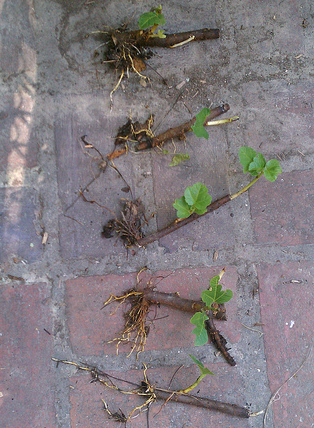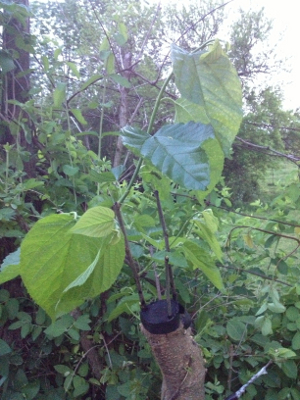
Rooting figs and grafting mulberries
 I
haven't been the only one having fun with grafting and rooting this
year --- two of our readers emailed this week with updates on
experiments of their own. Brian
wrote in to say that he ended up with accidentally-rooted fig cuttings
in his Tennessee garden:
I
haven't been the only one having fun with grafting and rooting this
year --- two of our readers emailed this week with updates on
experiments of their own. Brian
wrote in to say that he ended up with accidentally-rooted fig cuttings
in his Tennessee garden:
(I would have put an
exclamation point at least somewhere in that paragraph, so I'll add two
here for you to use as you see fit --- !!)
Brian also had quite
good success with his more intentional grafting and rooting efforts,
managing to salvage some very subpar cuttings I sent him. His
only real failure was trying to graft hardwood cuttings onto a peach
--- my understanding is that peaches are best budded in the summer, although I've
never tried it myself.
 Meanwhile, you may recall Gary,
who is experimenting with propagating Illinois Everbearing mulberries. The cuttings that
callused for him didn't end up rooting, but he had much better luck
with grafting Illinois Everbearing onto wild red mulberries around his
farm. He wrote:
Meanwhile, you may recall Gary,
who is experimenting with propagating Illinois Everbearing mulberries. The cuttings that
callused for him didn't end up rooting, but he had much better luck
with grafting Illinois Everbearing onto wild red mulberries around his
farm. He wrote:
I owe you updates on my
own rooting and grafting experiments (which have been a mixed bag, but
with some great successes). That will have to wait for another
post, though. In the meantime, I hope you'll be inspired by these
two success stories to give home-propagation of woody perennials a try.
Want more in-depth information? Browse through our books.
Or explore more posts by date or by subject.
About us: Anna Hess and Mark Hamilton spent over a decade living self-sufficiently in the mountains of Virginia before moving north to start over from scratch in the foothills of Ohio. They've experimented with permaculture, no-till gardening, trailersteading, home-based microbusinesses and much more, writing about their adventures in both blogs and books.
Want to be notified when new comments are posted on this page? Click on the RSS button after you add a comment to subscribe to the comment feed, or simply check the box beside "email replies to me" while writing your comment.

I just found this article online. Is it saying you tried grafting common backyard mulberries? Was it successful? I am guessing that part didn't work because you would suggest Mom do that here if it was. Still thought it worth asking.
Do you have a Meyer lemon? Did you know you can graft multiple kinds of oranges and limes on that tree? I am still researching for our lime.